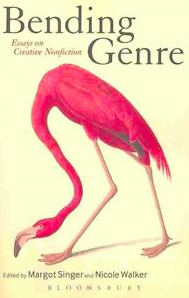Writers Read: Bending Genre “On Convention” by Margot Singer
 In “On Convention,” Margot Singer is less interested in defining what creative nonfiction is, and more interested in what it is doing and what it can do. She seeks to understand the evolving nature of the art of the genre, and how it blurs the lines between the “conventions,” of good writing—an imitation of mimetic literary prose—and the cultivated voice of creative nonfiction. Her belief is that creative nonfiction seeks to blend, or bend, conventions but also challenges the understanding of what creative nonfiction is by addressing the marriage between fact and imagination resulting in something she refers to as the Naked I.
In “On Convention,” Margot Singer is less interested in defining what creative nonfiction is, and more interested in what it is doing and what it can do. She seeks to understand the evolving nature of the art of the genre, and how it blurs the lines between the “conventions,” of good writing—an imitation of mimetic literary prose—and the cultivated voice of creative nonfiction. Her belief is that creative nonfiction seeks to blend, or bend, conventions but also challenges the understanding of what creative nonfiction is by addressing the marriage between fact and imagination resulting in something she refers to as the Naked I.
The essay examines how the imitation of fictional literary prose, mimetic writing, is used to create stories that feel as though they’re true and real. This is done through the traditional tools used in all creative writing: showing not telling, developing compelling characterization, well-crafted dialogue. But she also posits that in attempting to tell the story in this approach that it might read as true, however it is often less truthful than it would appear to be—the factual story doesn’t happen as easily as it appears to happen in linear nonfiction narratives. She believes that this blurring of fact and imagination is where the true art of CNF is coming from, particularly in the resulting voice of this amalgam.
[Creative nonfiction] is often less truthful than it would appear to be—the factual story doesn’t happen as easily as it appears to happen in linear nonfiction narratives.
Singer argues that the language of creative nonfiction, the eschewing the omniscient narrator, to expose the writer’s feelings is a way of baring the prose to expose the author’s “voice.” Voice is what Singer suggests is the true distinction between fiction and creative nonfiction, as well as creative nonfiction and purely factual texts.

Margot Singer, co-author of Bending Genre: Essays on Creative Nonfiction.
The Naked I, while often still using the conventions of mimetic literary writing, is a self-reflexive narrative voice that embodies the actual living “I” of the writer. Singer describes this voice as a combination of “hubris and humility.” Even when adhering to the Henry James standards of well-constructed writing (i.e. showing not telling), creative nonfiction is profoundly influenced by the writer’s relationship with this exposed Naked I. This voice necessitates the writer to address who they are in the relationship to the world that they are writing about, and how they find themselves when they are within that society. It can be done in the first person as in The Orchard Thief; the third person as in In Cold Blood; in semi-fictional accounts such as What is the What?, and even in unreliable nonfiction narration such as Amis’ Money.
Blurring the lines between what creative nonfiction writing is, and what creative nonfiction writing can do, turns away from the traditional voice of nonfiction texts to expose the bias and emotion of the narrator. The Naked I is coming from a new place, its voice unveils and confronts even while asking, “Is this the truth or what the writer believes to be the truth?”
This voice necessitates the writer to address who they are in the relationship to the world that they are writing about, and how they find themselves when they are within that society.
By combining the imitable qualities of conventional literary prose and crafting voice through the authentic revelation of the Naked I, is where Singer finds the art in creative nonfiction—definition of a formal term, she finds, is unnecessary.
Singer, Margot, and Nicole Walker. Bending Genre: Essays on Creative Nonfiction. Bloomsbury Academic, 2013. Print.






